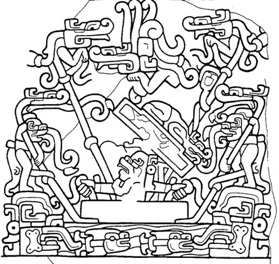AND in the Popol Vuh. Even so, it goes into great detail about the journey of the heavenly "bees" that caused great blisters, similar to hot resin or splashing, burning turpentine on both man a beast. M-109 appears to be when the main "bee god" leaves his home and leads his heavenly citizens to the Planet Earth, Yet, it was not until after the heavenly "bee" homes were cut with axes.
Even so, a common "pendulum" problem is found only illustrated as the six Tikal Bones with the Paddler Gods and their broken canoe as it "waffles like a pendulum" in the waters of the mythical star river called the Milky Way.
Even so, a common "pendulum" problem is found only illustrated as the six Tikal Bones with the Paddler Gods and their broken canoe as it "waffles like a pendulum" in the waters of the mythical star river called the Milky Way.
A grandfather clock is different, it is moving in relation to the wound-up spring inside the clock that is turned with a key every night. It is completely dependent up the holder of that key. If the key is not used by the person to tighten the spring, the clock will stop of its own accord.
But where the planet Earth is concerned, there is are two-whammies to consider. One, that it orbits around the sun during a year; and, two, that it also spins in a lop-sided circle every 24 hours. So in effect, we have a circle within a great oval. It is similar to the cog-like composites of the Maya calendar and how it handles the uneven day count (of 13 days) with the wildly different month count (of 20 months), that includes a larger cog of Katuns.
WOULD IT NOT BE INTERESTING IF it were in fact 13 MONTHS OF 20 DAYS EACH? One could probably then connect the information better to our own calendar years. But that is too simple an explanation. NEVERTHELESS, it is well documented that the calendar of Meso-America had been redesigned so many times that even Bishop Noriega of the Spanish church in Mexico in the XVIII century could not keep up with the changes made.
He, in frustration, wrote of those multiple changes his Despedida to the parishes within his See. For that matter, the Madrid Codex, shows that there were 20 days in each calendar month that began with Imix. But Imix was not a month, instead it seemed to start a 20-day cycle, having 18 "months" in one year of 360 days. That would have made it 180 days for one half of a year with a quarter of the year (as three of our months) or 90 days.
That, in turn, would have agreed with the cycles of the year (1) burning [90 days], (2) planting [90 days], (3) harvesting [90 days] and (4) 70 days for preparation for a grandiose "Thank you" festival for the Maize God [to be held during the last 20 days of the year]. A much more sensible calendar with a serious purpose. The above change to the calendar, even adding the five extra days would not be a disaster. And it would probably help in re-establishing proper year counts.
Respected researchers in the scholarly world actually did discover the 18 months of 20 days in each month. They are: Sahagún, J. Soustelle, M. Leon-Portilla, José Castillo-Torre, the hidden narrators of the Popol Vuh, [as an astronomy book] together with the Madrid Codex, is to mention just a few.
Who was it that chose to ignore these venerable scholars in favor of a more modern translations? By returning to their investigations, would that not create better calculations of the Maya calendar system?
WOULD IT NOT BE INTERESTING IF it were in fact 13 MONTHS OF 20 DAYS EACH? One could probably then connect the information better to our own calendar years. But that is too simple an explanation. NEVERTHELESS, it is well documented that the calendar of Meso-America had been redesigned so many times that even Bishop Noriega of the Spanish church in Mexico in the XVIII century could not keep up with the changes made.
He, in frustration, wrote of those multiple changes his Despedida to the parishes within his See. For that matter, the Madrid Codex, shows that there were 20 days in each calendar month that began with Imix. But Imix was not a month, instead it seemed to start a 20-day cycle, having 18 "months" in one year of 360 days. That would have made it 180 days for one half of a year with a quarter of the year (as three of our months) or 90 days.
That, in turn, would have agreed with the cycles of the year (1) burning [90 days], (2) planting [90 days], (3) harvesting [90 days] and (4) 70 days for preparation for a grandiose "Thank you" festival for the Maize God [to be held during the last 20 days of the year]. A much more sensible calendar with a serious purpose. The above change to the calendar, even adding the five extra days would not be a disaster. And it would probably help in re-establishing proper year counts.
Respected researchers in the scholarly world actually did discover the 18 months of 20 days in each month. They are: Sahagún, J. Soustelle, M. Leon-Portilla, José Castillo-Torre, the hidden narrators of the Popol Vuh, [as an astronomy book] together with the Madrid Codex, is to mention just a few.
Who was it that chose to ignore these venerable scholars in favor of a more modern translations? By returning to their investigations, would that not create better calculations of the Maya calendar system?


No comments:
Post a Comment